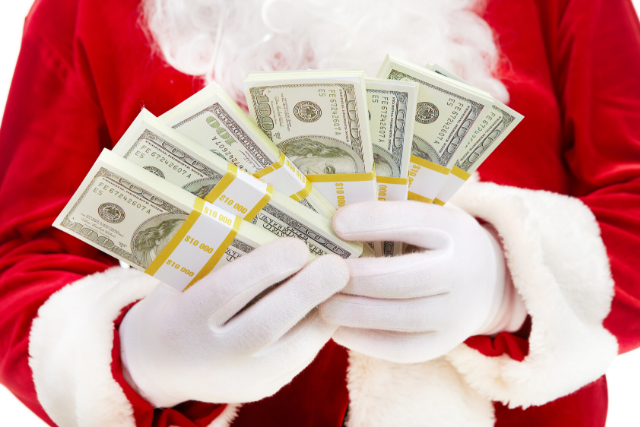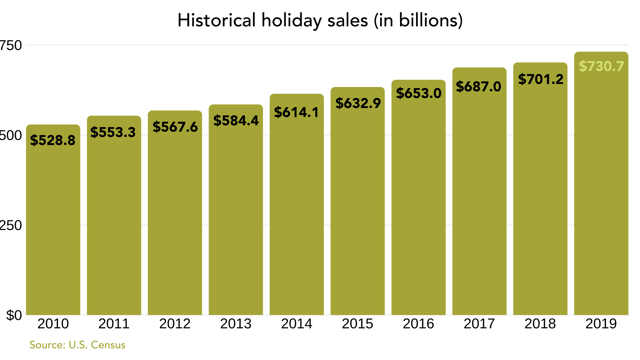
Feliz navidad? More like feliz navi-DEBT.
The holiday season is the time of year when people spend the most, mainly on gifts for their loved ones. It’s easy to throw caution to the wind and just blow your budget regardless of the consequences. And the rise of mobile shopping has only made it easier to drop hundreds, perhaps thousands of dollars on shiny new objects. In fact, industry experts expect the average American to spend $920 per person on holiday gifts in 2019 — $885 more than 2018 — reaching a total of more than $1 trillion in holiday spending.
You may even have to spend more on a Christmas tree this year after unseasonably warm weather wreaked havoc on evergreen firs.
Even though there’s something oddly heartwarming about the money people are willing to spend to make Christmas special for others, the holiday debt trend is as glaring as Rudolph’s red nose.
When did it get this way?
Christmas was first declared an official holiday in Alabama during mid-19th century. From there, holiday fever spread rapidly across the country. As the popularity of December 25th grew, so did Christmas commerce. It’s no small coincided that the rise of contemporary Christmas blossomed at a time when America was seeing a massive increase in industrialization. There was money to go around. And where there's money, there's wiggle room to buy things. Or in this case: Gifts.
Commercial Christmas presents started to become common during the 1820s, and the economy became more dependent upon Christmas sales over time. By the late 19th century, store owners began developing strategies to make Christmas shopping more enjoyable for shoppers and more lucrative for themselves. Store window displays gave passerby a glimpse of the ideal American Christmas, price tag and all.

Window shopping became a holiday past time in the 1800s when the widespread availability of plate glass allowed shop owners to build large windows to display their merchandise.
By the early 20th century, Christmas had become a centerpiece of U.S. commerce, and Christmas season one of the most profitable periods for retailers.
Today, Christmas is arguably the most universally recognized holiday around the world. Are you even surprised anymore when you see the Christmas aisle appear at Walgreen’s before Halloween is over?

The reason we spend so darn much.
There's something undeniably satisfying about watching a person unwrap a gift and respond with a joyous squeal. That feeling is worth far more than money or any material item.
Because of this, it’s easy to tell yourself “This is the perfect gift for so-and-so, I have to get it!” Your intentions are good, but that doesn’t make it OK to overspend and impact the rest of your year for a fleeting positive reaction.
When it comes to holiday expenses, aim to strike a good balance between keeping family happy and your bank balance healthy.
Let's rethink gift giving.
Presents are not a social obligation.
When you feel like you have to give gifts to certain people during the holidays, you’re more likely to waste money on presents that have little value to the recipient. Instead of sending stocking stuffers to all 100 of your co-workers, save that money for the kids in your life. Kids will always be more appreciative of a gift than adults, no matter what it is or how much it costs.
Your income should determine how much you spend.
One good rule of thumb is to only spend 1% of your overall income on the holidays. So, if your combined household earnings are $120,00, try limiting your holiday spending to $1,200. While you may end up spending more or less, this is roughly what a “reasonable” holiday budget looks like.
Erase “perfect” from your vocabulary.
Stop putting unnecessary pressure on yourself. Christmas is supposed to be fun! Whatever idealized vision for gifts and the holidays you’re imagining, erase them from your mind. High expectations can lead to disappointment, depression, and anxiety. You’ll have a better time staying present and enjoying the moment before it becomes Christmas past.
DIY when you can.
If you’re feeling creative, why not put your skills to good use and make something really unique? Hop onto Pinterest or Instagram to get some ideas for crafts that you can give as Christmas gifts.
Help others with gifts.
If you see an item that you know somebody wants, but you’re already over budget — why not pass the idea on to someone who is also close with them? Sometimes being someone’s “Christmas consultant” can feel just as satisfying as playing Santa. Just make sure you’re not a total Grinch who takes credit for the gift once it’s given.
Spend time, not money.
Christmas is a holiday rooted in nostalgia. Ask anyone about their childhood Christmas and they can likely paint a detailed picture of the scene. People place a lot of value on their past memories, to the point where they can actually convince themselves it was better than it actually was. Someone who went sledding once on Christmas eve in 1999 could easily tell people “We used to go sledding all the time during Christmas!” and actually believe it! Moments make the holidays special, and they don’t have to be expensive to be memorable. So many activities and traditions are inexpensive, or even free.
Here are some inexpensive (or free) activities that can make Christmas memorable for you and your loved ones.
- Hang ornaments as a family.
- Drive around the neighborhood to admire Christmas lights.
- Watch a Christmas classic over a mug of hot cocoa at home.
- Bake together.
- Go caroling.
- Make a gingerbread house.
- Design your own ugly Christmas sweater.
Sources:
https://www.investopedia.com/financial-edge/1112/average-cost-of-an-american-christmas.aspx
http://citeseerx.ist.psu.edu/viewdoc/download?doi=10.1.1.838.7196&rep=rep1&type=pdf
Like this article? Subscribe to our blog and have great financial insights delivered to your inbox weekly.



